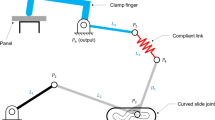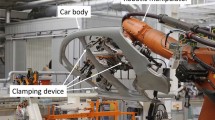Abstract
The problem of clamping complex or low-stiffness parts in technically and economically advantageous conditions is of interest for many manufacturing companies. An emerging method for this type of parts is fixing with adhesive. This paper proposes a new adhesive fixing method for low-rigidity parts, using adhesive tape. The use of adhesive tape minimizes the vibrations induced by the tool in the workpiece and minimizes chatter. This method, although simple and cheap, has not been considered before. The validation of this fixing method was done after a series of tests to determine the holding capacity and stability of the fixed part during the machining process. Therefore, a fixture was designed and manufactured to determine the tensile and shear load capacity of adhesive tapes. Two types of parts from different materials and shapes were machined to determine the stability of the fixed part during machining. After determining the dimensional, shape, and positional accuracy, the method was found to be valid. The method has a high potential for clamping parts with low rigidity for machining.





















Similar content being viewed by others
References
Joshi PH (2002) Jigs and fixtures. Design manual, 2nd ed. McGraw-Hill
Venkataraman K (2022) Design of jigs, fixtures and press tools. Springer
Nee AYC, Whybrew K, Senthil kumar A (1995) Advanced fixture design for FMS. Springer London, London
Qin G (2021) Advanced fixture design method and its application. Springer Singapore, Singapore
Hoffman EG (2004) Jig and fixture design, 5th ed. Thomson/Delmar Learning, Clifton Park, NY
Raffles MH, Kolluru K, Axinte D, Llewellyn-Powell H (2013) Assessment of adhesive fixture system under static and dynamic loading conditions. Proc Inst Mech Eng B J Eng Manuf 227:267–280. https://doi.org/10.1177/0954405412468217
Gameros A, Lowth S, Axinte D et al (2017) State-of-the-art in fixture systems for the manufacture and assembly of rigid components: a review. Int J Mach Tools Manuf 123:1–21. https://doi.org/10.1016/j.ijmachtools.2017.07.004
De Meter EC (2004) Light activated adhesive gripper (LAAG) workholding technology and process. J Manuf Process 6:201–214. https://doi.org/10.1016/S1526-6125(04)70075-4
Yao S, Ozturk E, Curtis D, McLeay T (2020) Work holding assessment of an UV adhesive and fixture design method. Int J Adv Manuf Technol 106:741–752. https://doi.org/10.1007/s00170-019-04635-9
Biszczanik A, Talaśka K, Wilczyński D (2022) Analysis of the adhesive spread and the thickness of the adhesive bonded joint depending on the compressive force applied to bonded materials with different surface structure. Int J Adhes Adhes 114:103081. https://doi.org/10.1016/j.ijadhadh.2021.103081
De Meter E, Chow KH, Marsh E (2019) Methodology of using PAAW and the underlying support network of an L-PBF part to facilitate machining. Procedia Manuf 34:463–474. https://doi.org/10.1016/j.promfg.2019.06.199
ASTM F2258-05 (2015) Standard test method for strength properties of tissue adhesives in tension. ASTM International, Developed by subcommitettee F04.15. https://doi.org/10.1520/F2258-05R15
ASTM F2255-05 (2015) Standard test method for strength properties of tissue adhesives in lap-shear by tension loading. ASTM International, Developed by subcommitettee F04.15. https://doi.org/10.1520/F2255-05R15
Ma J, Li Y, Zhang D et al (2022) Dynamic response prediction model of thin-wall workpiece-fixture system with magnetorheological damping in milling. J Manuf Process 74:500–510. https://doi.org/10.1016/j.jmapro.2021.12.050
Altintas Y, Weck M (2004) Chatter stability of metal cutting and grinding. CIRP Ann 53:619–642. https://doi.org/10.1016/S0007-8506(07)60032-8
Quintana G, Ciurana J (2011) Chatter in machining processes: a review. Int J Mach Tools Manuf 51:363–376. https://doi.org/10.1016/j.ijmachtools.2011.01.001
Wu G, Li G, Pan W et al (2021) A state-of-art review on chatter and geometric errors in thin-wall machining processes. J Manuf Process 68:454–480. https://doi.org/10.1016/j.jmapro.2021.05.055
Tehranizadeh F, Berenji KR, Yıldız S, Budak E (2022) Chatter stability of thin-walled part machining using special end mills. CIRP Ann 71:365–368. https://doi.org/10.1016/j.cirp.2022.04.057
Wang W-K, Wan M, Zhang W-H, Yang Y (2022) Chatter detection methods in the machining processes: a review. J Manuf Process 77:240–259. https://doi.org/10.1016/j.jmapro.2022.03.018
Braun S, Ewins DJ, Rao SS (2002) Encyclopedia of vibration. Academic Press, San Diego
Leissa AW (1973) Free vibration of rectangular-plates. J Sound Vib 31:257–293
Karami G, Malekzadeh P (2003) Application of a new differential quadrature methodology for free vibration analysis of plates. Int J Numer Meth Engng 56:847–868. https://doi.org/10.1002/nme.590
Panc N, Contiu G, Bocanet V (2019) Comparative analysis of surface finishing for different cutting strategies of parts made from POM C. In: Hloch S, Klichová D, Krolczyk GM et al (eds) Advances in Manufacturing Engineering and Materials. Springer International Publishing, Cham, pp 324–332
Trifunović M, Madić M, Janković P et al (2021) Investigation of cutting and specific cutting energy in turning of POM-C using a PCD tool: analysis and some optimization aspects. J Clean Prod 303:127043. https://doi.org/10.1016/j.jclepro.2021.127043
Axinte D, Guo Y, Liao Z et al (2019) Machining of biocompatible materials — recent advances. CIRP Ann 68:629–652. https://doi.org/10.1016/j.cirp.2019.05.003
Tschätsch H (2009) Applied machining technology. Springer, Berlin Heidelberg, Berlin, Heidelberg
Zeng S, Wan X, Li W et al (2012) A novel approach to fixture design on suppressing machining vibration of flexible workpiece. Int J Mach Tools Manuf 58:29–43. https://doi.org/10.1016/j.ijmachtools.2012.02.008
Bocanet V, Panc N (2017) The influence of hole finishing strategies on quality. MATEC Web Conf 137:03001. https://doi.org/10.1051/matecconf/201713703001
Panc N, Vuscan I, Balc N (2013) Research on the deformations caused by the manufacturing devices onto the parts with low rigidity. Acad J Manuf Eng 11:10–13
Agarwal A, Desai KA (2020) Tool and workpiece deflection induced flatness errors in milling of thin-walled components. Procedia CIRP 93:1411–1416. https://doi.org/10.1016/j.procir.2020.04.101
Pimenov DY, Guzeev VI, Krolczyk G et al (2018) Modeling flatness deviation in face milling considering angular movement of the machine tool system components and tool flank wear. Precis Eng 54:327–337. https://doi.org/10.1016/j.precisioneng.2018.07.001
Wan X-J, Zhang Y, Huang X-D (2013) Investigation of influence of fixture layout on dynamic response of thin-wall multi-framed work-piece in machining. Int J Mach Tools Manuf 75:87–99. https://doi.org/10.1016/j.ijmachtools.2013.09.008
Zhang Z, Qi Y, Cheng Q et al (2019) Machining accuracy reliability during the peripheral milling process of thin-walled components. Robot Comput Integr Manuf 59:222–234. https://doi.org/10.1016/j.rcim.2019.04.002
Author information
Authors and Affiliations
Contributions
All authors contributed to the study conception and design. Material preparation, data collection, and analysis were performed by NAP, CV, and VB. Workpieces was machined by HC and IAP. The first draft of the manuscript was written by NAP, and all authors commented on previous versions of the manuscript. All authors read and approved the final manuscript.
Corresponding author
Ethics declarations
The authors declare no competing interests.
Additional information
Publisher’s Note
Springer Nature remains neutral with regard to jurisdictional claims in published maps and institutional affiliations.
Rights and permissions
Springer Nature or its licensor (e.g. a society or other partner) holds exclusive rights to this article under a publishing agreement with the author(s) or other rightsholder(s); author self-archiving of the accepted manuscript version of this article is solely governed by the terms of such publishing agreement and applicable law.
About this article
Cite this article
Panc, N.A., Bocaneț, V., Vilău, C. et al. New method of fixturing the low-rigidity parts by adhesive clamping. Int J Adv Manuf Technol 129, 2591–2608 (2023). https://doi.org/10.1007/s00170-023-12429-3
Received:
Accepted:
Published:
Issue Date:
DOI: https://doi.org/10.1007/s00170-023-12429-3




